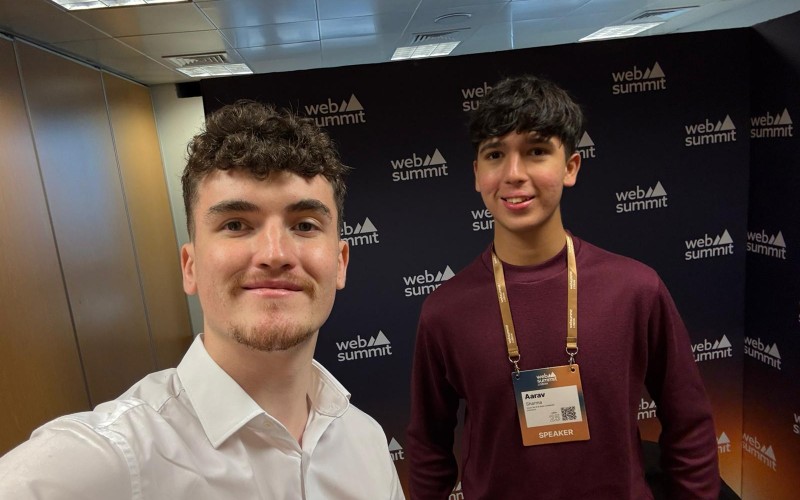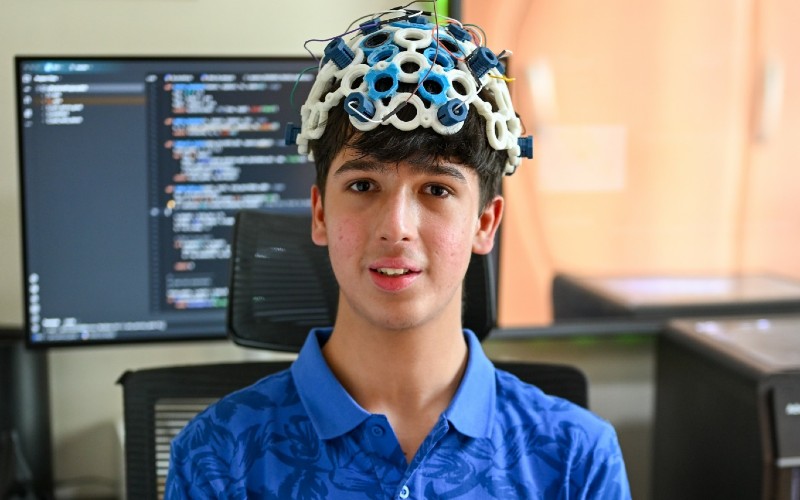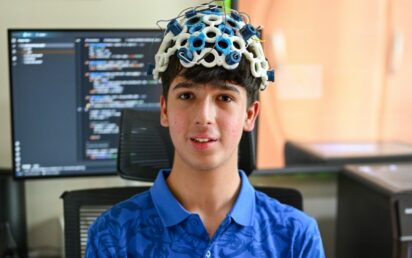At just 15 years old, Aarav Sharma is working on something most people his age could only dream of – a brain-computer interface (BCI) controlled exoskeleton arm designed to restore mobility for individuals with paralysis.
The grade 10 student at UWC South East Asia is at Web Summit this week and has already taken to the stage to share his insights.
The Singapore-based student sat down with BusinessCloud to expand on his remarkable story.
@businesscloud.co.ukIt’s Web Summit Day Two! Lots of big moves for the boys in blue today, as BusinessCloud embarks on day two of the flagship event Highlights included interviews with Sarah Franklin and Arvind Jain, the KPMG Global Tech Innovator Final and insight into a 15-year-old tech star #WebSummit #tech #uktech #business
“The main project that I’m making is using prosthetic arms and then controlling it with your mind – simply through brain-computer interfaces,” he explains.
“The main way I got the opportunity to present at Web Summit was through invitation, because I usually just post about my work online.
“I didn’t even give them my email address, but I think from what they had seen online, they were quite interested.”
A head start in technology
Aarav’s fascination with technology began early, something which he acted on.
“I’ve always been into tech since I was like 10 years old,” he tells BusinessCloud.
“From there, I was exploring early-stage robotics, just getting my understanding.
“Then when I was closer to 14, I wanted to go a lot deeper – into emerging technology, like computer interfaces, artificial intelligence and robotics.
“Now I want to push it further, maybe into a startup or company in the future. That’s kind of where I’m at at 15.”
Balancing that ambition with schoolwork might sound impossible, but he insists it comes down to structure.
“Mostly just time management, creating a really good calendar, a really good timetable,” he says on how to make it work.
“You have seven hours of school every day, sleep eight hours and then you still have about nine hours left.
“You just maximise that time for what you really want to pursue.
“If people actually just put it down in the calendar and identify what they’re doing, they’d understand that they’re not really that busy.
“So it’s just about using that time and understanding what your actual workload is – and using that to your leverage.”

Aarav Sharma with BusinessCloud’s Patrick Killeen
Discipline
That discipline is driven by passion rather than obligation.
He continues: “You always need to have that drive, that motivation.
“Even if you do have all that time but don’t really care about what you’re doing, there’s no point.
“You show up every day, maybe work for two or three hours, but you won’t get anything out of it.
“Having that passion makes you push yourself even further without anyone telling you to.”
Alongside his robotics work, Aarav is also tackling food waste reduction in schools, though his main focus remains on developing the exoskeleton.
He explains: “I’m still in the developing and manufacturing stage – making version two of the whole system.
“Version one currently has the user think about opening or closing the arm and it does those key movements.
“In versions two, three and four, I want to increase the output so the user can move the arm up, down, left and right.
“Those movements would be really cool for real-life applications, like eating food or riding a bicycle.”
Raised investment
Aarav has already raised investment for the project, with people around him believing in his ideas and execution.
“The initial startup cost was fairly high – around $20,000 – but I managed to get investors to actually pay that for me,” he says.
“So far, I’m mostly looking for mentorship and opportunities, but also investors as well.”
He admits that being taken seriously as a 15-year-old hasn’t always been easy.
He continues: “A couple of times, yeah, people might talk down a bit at the start, but that’s usually just the first 10 or 20 seconds of a conversation.
“After that, once they get over the fact that you are 15, they know if you’re actually passionate and know what you’re doing.
“If you talk like you’re 15, they’ll see you as 15.
“But when you talk like you’re 30 or 40 years old, they’ll think that you are that age and they’ll give you the exact same opportunities.”
Learning from leaders
At Web Summit Lisbon, where Aarav was invited to showcase his work, he’s been making the most of every opportunity.
“Mostly I’m just networking with other people,” he says.
“Earlier yesterday I spoke with the CEO of Red Bull Racing for the F1 team, and just half an hour ago, I spoke to the CEO of Lyft.
“It was about learning their stories – understanding how they got their companies to success, their leadership skills, their philosophy.
“At the start, I definitely had that feeling of being overwhelmed.
“I saw so many people and not many people my age, but once you get into the rhythm of it, it’s natural. Now I don’t feel intimidated by anyone.”
‘Helping people first – the rest will follow’
Looking ahead, Aarav’s goal is to continue refining the exoskeleton until it rivals invasive alternatives like Neuralink.
“The main plan is just continuing to further refine the product,” he says.
“Right now, I’m on version two, but I want to keep adding controls until users can do as many things as they would with a regular arm.
“One main thing that’s better than Neuralink is that it’s non-invasive – you don’t need surgery, just a headset similar to a cap.
“My main mission is to make my own company.
“If something gets in the way, then I’ll have a fallback – continuing my education and working in a corporate job if needed, but my priority is always starting my own startup.”
Like many young innovators, and maybe opposed to the norm, he is driven more by purpose than profit.
“If you start with pure intention – helping people —-everything will go to success and the money will come later,” he says.
“If you start by thinking, ‘I want to make money,’ and then look for a project, it’s harder.
“If you start with a project that impacts people, everything else will follow.”
Rhinoflux wins KPMG Global Tech Innovator 2025 at Web Summit


